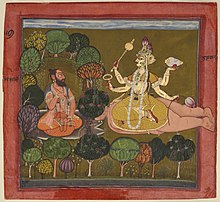Brahmin

Brahmin ( sanskritisht: ब्राह्मण ) është një varna si dhe një kastë brenda shoqërisë hindu . Në nënkontinentin Indian Vedik dhe pas-Vedik, Brahminët u caktuan si klasa priftërore, duke shërbyer si priftërinj ( purohit, pandit ose puxhari ) dhe mësues shpirtëror ( guru ose açarja ). Tre varnat e tjera janë Kshatrija, Vaishja dhe Shudra . [1] [2] [3] [4] [5]
Puna tradicionale e brahminëve është ajo e priftit në tempujt hindu ose në ceremonitë socio-fetare, dhe kryerja e ritualeve të riteve të kalimit, si solemnizimi i një martese me himne dhe lutje. [6] Tradicionalisht, brahminëve u jepet statusi më i lartë ritual i katër klasave shoqërore. [7] Në praktikë, tekstet indiane sugjerojnë se disa brahminë historikisht u bënë edhe bujq, luftëtarë, tregtarë dhe kishin mbajtur gjithashtu profesione të tjera në nënkontinentin Indian. [7]

- ^ Benjamin Lee Wren (2004). Teaching World Civilization with Joy and Enthusiasm. University Press of America. fq. 77–. ISBN 978-0-7618-2747-4.
At the top were the Brahmins(priests), then the Kshatriyas(warriors), then the vaishya(the merchant class which only in India had a place of honor in Asia), next were the sudras(farmers), and finally the pariah(untouchables), or those who did the dirty defiling work
{{cite book}}: Mungon ose është bosh parametri|language=(Ndihmë!) - ^ Kenneth R. Valpey (2 nëntor 2019). Cow Care in Hindu Animal Ethics. Springer Nature. fq. 169–. ISBN 978-3-03-028408-4.
The four varnas are the brahmins (brahmanas—priests, teachers); kshatriyas (ksatriyas—administrators, rulers); vaishyas (vaisyas—farmers, bankers, business people); and shudras(laborers, artisans)
{{cite book}}: Mungon ose është bosh parametri|language=(Ndihmë!) - ^ Richard Bulliet; Pamela Crossley; Daniel Headrick; Steven Hirsch; Lyman Johnson (11 tetor 2018). The Earth and Its Peoples: A Global History, Volume I. Cengage Learning. fq. 172–. ISBN 978-0-357-15937-8.
Varna are the four major social divisions: the Brahmin priest class, the Kshatriya warrior/ administrator class, the Vaishya merchant/farmer class, and the Shudra laborer class.
{{cite book}}: Mungon ose është bosh parametri|language=(Ndihmë!) - ^ Akira Iriye (1979). The World of Asia. Forum Press. fq. 106. ISBN 978-0-88273-500-9.
The four varna groupings in descending order of their importance came to be Brahmin (priests), Kshatriya (warriors and administrators), Vaishya (cultivators and merchants), and Sudra (peasants and menial laborers)
{{cite book}}: Mungon ose është bosh parametri|language=(Ndihmë!) - ^ Ludo Rocher (2014). "9.Caste and occupation in classical India: The normative texts". përmbledhur nga Donald R. Davis, Jr (red.). Studies in Hindu Law and Dharmaśāstra. Anthem Press. fq. 205–206. ISBN 9781783083152.
{{cite book}}: Mungon ose është bosh parametri|language=(Ndihmë!) - ^ Gabim referencash: Etiketë
<ref>e pavlefshme; asnjë tekst nuk u dha për refs e quajturaghurye15 - ^ a b Doniger, Wendy (1999). Merriam-Webster's encyclopedia of world religions. Springfield, MA, US: Merriam-Webster. fq. 141–142, 186. ISBN 978-0-87779-044-0.
{{cite book}}: Mungon ose është bosh parametri|language=(Ndihmë!)
